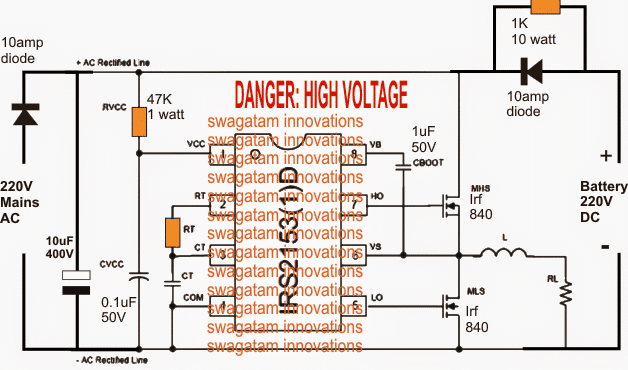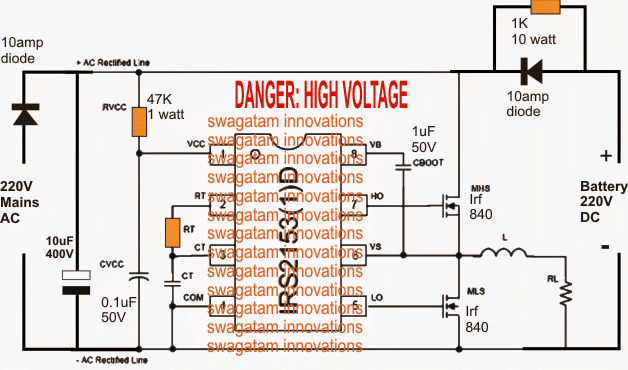In this post I have explained a simple 220 V to 220V DC online UPS inverter circuit. The idea was requested by Mr. Taiye.
Technical Specifications
I intend to build a 1000 watt UPS with a different concept (inverter with high voltage input dc).
I will use a battery bank of 18 to 20 sealed batteries in series each 12 volts/ 7 Ah to give a 220+ volts storage as input to a transformerless inverter.
Can you suggest a simplest possible circuit for this concept which should include a battery charger + protection and auto switching by mains failure. Later I will include a solar power input too.

Warning: The above circuit is not isolated from mains AC, and therefore is extremely dangerous to touch in the powered and open condition. You should be extremely careful while building and testing this circuit, and make sure to take the necessary safety precautions. The author cannot be held responsible for any mishap due to any negligence by the user
The Design
A very simple design can be witnessed in the above diagram for the proposed 220V DC UPS inverter circuit. Thanks to the IC IRS2153 from International Rectifiers which has everything included inside one package for the required implementation..
Basically, the IC is a specialized half bridge mosfet driver unit having all the required safety parameters built-in, so that we don't have to bother about these while building a customized half-bridge inverter circuit.
As can be seen in the diagram, there's hardly anything complicated, it's just about integrating the mains input and an equivalently rated battery at the other side for implementing a hassle free 220V online UPS circuit which is solid state in design, noiseless, and transformerless.
The Rt and Ct are appropriately selected for achieving the required 50 or 60Hz frequency for the output load.
It may be done by using the following formula:
f = 1/1.453× Rt x Ct, where Ct will be in Farads, Rt in Hz, and f in Hz.
L1 may be selected with some experimentation so that the square wave harmonics can be controlled to some favorable extent.
Here, to avoid complication an automatic over charge cut off feature is not included, rather a trickle charge feature is opted for charging the battery. This may take a relatively longer time for the battery to get charged but the dangers of over charge is eliminated and reduced to safe levels.
The 1K 10 watt resistors determines the charging rate for the battery, optionally the battery could be charged through a suitable external charger circuit.
UPDATE:
Since a half bridge driver IC is used in the above design, the output will be a half wave output, meaning for a 310V DC input the output will be around 130V RMS, although the peaks will be still 310 V
To get get a full wave or a full 220V RMS, please replace the half bridge circuit with a full bridge driver IC circuit
